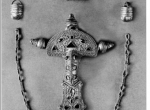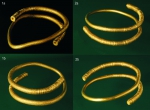Młoteczno
Młoteczno, Braniewo district, Warmian-Masurian Voivodeship (Germ. Hammersdorf, Kr. Braunsberg), site of discovery between 1873 and 1917, in different parts of the village, of at least 17 gold and silver objects; of this group today the following are known: 1. a medallion of Constantius II from the Constantinople mint, 335-336; 2. fragments of two silver vessels, one provenanced to Italy or Gaul, the other eastern Roman; 3. three basket pendants; 4. A gold brooch with a gold chain, L. 13.2 cm; 5. two gold necklaces type Piotrowice (fig. 1.). At present only the two necklaces survive in the Pushkin State Museum of Fine Arts in Moscow, previously in Museum für Völkerkunde in Berlin; the remainder, held by the Königsberg museum went missing during World War II. Treated at first as a uniform deposit they were separated by M. Ebert into two chronologically discrete groups: an earlier - the brooch, pendants and vessels, and a later – two necklaces. According to A. Bursche the objects may have belonged to even more than two groups.
The brooch, in →Polychrome Style , set with garnets and amber, decorated with filigree and granulation, belongs to the group of brooches type Nežin-Szilágysomlyó-Regöly-Untersiebenbrunn →Sösdala-Untersiebenbrunn Style datable to the early phase D2 of the →Migration Period , which corresponds to the end of the 4th and the first quarter of the 5th century. Its origin – local or Danubian – continues to be discussed; the garnet inserts support the Danubian provenance, the filigree, granulation and the shape of the knobs on the head – a local one. The basket pendants, first recorded during phase C2, may be contemporary with the brooch; this is suggested by details used in making their ornamentation. The latest possible dating for the silver vessels is early 5th century, for the two necklaces – 6th century.
MM
Literature : N. Åberg, Ostpreussen in der Völkerwanderungszeit, Uppsala 1919, p. 67-68; F. E. Peiser, Der Goldfund von Hammersdorf, Mannus 10, 1919, p. 92-96; M. Ebert, Neuerwerbungen des Prussia-Museums. VI. Völkerwanderungszeit, Prussia XXIV, 1923, p. 159; H. Bott, Zur Datierung der Funde aus Hammersdorf (Ostpreussen), Jahrbuch des Römisch-Germanischen Zentralmuseums Mainz 23/24, 1982, p. 139-153; G. Hirschfeld, Bruchstücke von zwei silbernen Geräten, Prussia XI, 1884-1885 (1886), p. 77-82; A. Bursche, Złote medaliony rzymskie w Barbaricum. Symbolika prestiżu i władzy społeczeństw barbarzyńskich u schyłku starożytności, Światowit, Supplement Series A: Antiquity 2, Warszawa 1998, p. 76-79, 237; G. Mangelsdorf, Der Halsring von Peterfitz, Hinterpommern. Ein Beitrag zur zeitlichen und kulturellen Stellung der Goldringe mit verdickten und übergreifenden Enden des 6. Jahrhunderts in Skandinavien und südlich der Ostsee, Offa 63/64, 2006/2007 (2011), p. 79-108; W. Menghin (ed.), Merowingerzeit. Europa ohne Grenzen, Berlin 2007, no. cat. IV.1.1-2; A. Cieśliński, Kulturelle Veränderungen und Besiedlungsabläufe im Gebiet der Wielbark-Kultur an Łyna, Pasłęka und oberer Drwęca, Berliner Beiträge zur Vor- und Frühgeschichte N. F. 17, Berlin 2010, p. 162-168.
-
 full resolution
full resolution
Fig. 1. Some items from the Młoteczno Hoard (A. Cieśliński 2010).
-
 full resolution
full resolution
Fot. 2. Two gold neckrings from Młoteczno, Braniewo District, end of the 4th – mid-5th c.; stored in the collection of the Pushkin Museum of Fine Arts in Moscow, (after V.I. Kulakow 2007)


